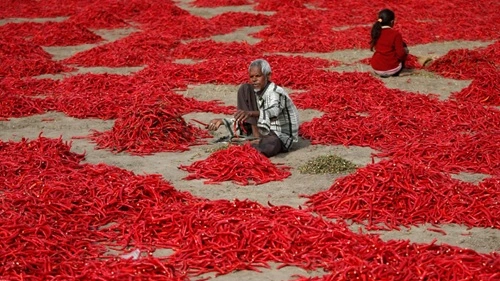It is not a hidden fact that we Indians are quite fond of Chillies, and why shouldn’t we? Chillies are a super important part of our Indian cuisine, and that’s precisely why India is the largest Chilli producer in the entire world. Though we’re talking about the total production, no matter the type or variety of chillies. And sure enough, since there is an important spot for chillies in Indian cuisine, that’s why they’re grown in literally every part of the country. But for now, let’s focus on the Top 5 Largest Chilli Producing States In India 2025. Here we go.

1. Andhra Pradesh
We are kicking off with a BIG one in Andhra Pradesh, and it’s no wonder. The state has kept its #1 place by making an amazing 1,212.90 thousand tonnes of chillies, which is more than 41% of the total output of India. An interesting thing is that whereas the amount of exports puts the state of Andhra Pradesh in the first place, the legacy is the one that gives the state its top position. One of the most famous Indian chilies, Guntur Sannam, which is generally grown in the Guntur area, is a brand that is known worldwide in the spice markets. The vibrant red color, sharp pungency, and exportable quality of the chilli have led it to be awarded a Geographical Indication (GI) tag as well.
2. Telangana
Not only is Telangana next to Andhra in the map, but it is also second by a small distance in the chilli race. The state made 794.42 thousand tonnes of dry red chilli in the year 2025, which accounted for nearly 27.30% of the total production of the country. Massive agri-market hubs in Warangal and Khammam are the backbone of chilli trade in the state, where “mirchi yards” that are specially built for trade by the chilli industry, transport truckloads of chillies on a regular basis. One of the great things about Telangana is that it is a continuous chilli belt that joins Andhra’s chilli heartland without any break, two different regions that have come together to form one big chilli ecosystem, helping farmers get good yields.
3. Madhya Pradesh
Madhya Pradesh is in the third position, and it is likely that this state is not able to produce as much as the first two; however, it has been making a positive climb in the chilli map with its output of 301.56 thousand tonnes (approximately 10.36% of India’s total production), and the growth has been both consistent and remarkable. The Nimar area, such as the districts of Khargone and Barwani, has seen a significant trend in the cultivation of chilli. In these places, not merely chilli has transformed into a money-making crop, but the entire chilli sector has become the cash crop of the region.
4. Karnataka
The state of Karnataka is not only the fourth largest volume producer with a total of 280.63 thousand tonnes, but also the fourth most noteworthy state because of its reputation. Byadagi is the home of the Byadagi chilli, a brand that is widely known not only in Indian kitchens but also in the cosmetics and food industries because of its vibrant red color and mild heat. The Byadagi and Ranebennur markets are bustling during peak seasons, drawing buyers from all corners of the country.
5. Odisha
With a production of 89.00 thousand tonnes of chillies in 2025, Odisha slid down to the fifth position, accounting for approximately 3.06% of the total production of the country. While the southern giants have focused their production in coastal areas, Odisha’s chilli production is mainly from the interior regions, such as Kandhamal, where a combination of traditional farming methods and good climate has made chilli a reliable crop. Maybe that does not have the same market facility or worldwide fame, but the steadiness of Odisha maintains it among the top five every year.
Conclusion
There you have it. If chillies are what we’re talking about, no doubt, we can’t just skip past these states. So much so, these states are also the ones responsible for exporting these chillis to other nations as well.